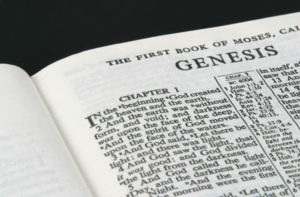The Literary Structure and Unity of the Book of Genesis

The problem with scholars who apply the historical-critical method (premised on methodological atheism rather than on believing, critical realism) on Genesis is that they refuse to acknowledge what is in plain sight, that is, the unity of Genesis. One of the clues to the unity of Genesis is found in the way in which the phrase “These are the generations of” (’elleh tôledôt) is used ten times at crucial transitions of the narratives in Genesis.
Nahum Sarna explains,
The ’elleh toledot formula is one of the distinguishing characteristics of the Book of Genesis. In each of its other ten occurrences, it introduces what follows, invariably in close connection with the name of a person already mentioned in the narrative. Its use indicates that a new and significant development is at hand. Deriving from the verb y-l-d, “to give birth,” the noun form would mean “begettings” or “generations,” and in most instances it precedes genealogies that are sometimes interspersed with narrative material. In 25:19 and 37:2, where no family tree follows but only stories of subsequent events, the formula is used figuratively for “a record of events.” This is the meaning it bears in the present passage. In this sense, the entire verse may be understood as a unity referring to what follows. Further support for this interpretation lies in its parallel structure, not to mention its poetic chiasm, “heaven and earth,” “earth and heaven.” [Nahum Sarna, Genesis (Jewish Publication Society, 1989), pp. 16-17]
Allen Ross adds,
The structure of the book is marked by an initial section and then ten further sections with headings. The major structural word of the book is tôledôt, expressed in the clause “these are the generations of.…” The word is a feminine noun from yālad, “to give birth” (properly derived from the hiphil stem of the verb, meaning “to beget”). It is often translated as “generations,” “histories,” or simply “descendants.”
This word has been traditionally viewed as a heading of a section. Reconstructing the outline according to this view would yield the arrangement below. (See C. F. Keil and F. Delitzsch, Biblical Commentary on the Old Testament: The Pentateuch, trans. James Martin [Grand Rapids: Eerdmans, 1949 reprint], pp. 70–71; Bush, Notes, p. 57; Leupold, Exposition of Genesis, vol. 1, pp. 109–11.)
1. Creation (1:1–2:3)
2. Tôledôt of the heavens and the earth (2:4–4:26)
3. Tôledôt of Adam (5:1–6:8)
4. Tôledôt of Noah (6:9–9:29)
5. Tôledôt of Shem, Ham, and Japheth (10:1–11:9)
6. Tôledôt of Shem (11:10–26)
7. Tôledôt of Terah (11:27–25:11)
8. Tôledôt of Ishmael (25:12–18)
9. Tôledôt of Isaac (25:19–35:29)
10. Tôledôt of Esau, the father of Edom (twice) (36:1–8; 36:9–37:1)
11. Tôledôt of Jacob (37:2–50:26)
And:
In order to understand the significance of the word tôledôt, we must interpret its meaning in the present arrangement of the book. Since tôledôt is related to the word yālad, it refers to the product or the result of its subject, which is marked out by the subjective genitive. This subject marks the starting point in the narrative; the section combines narrative and genealogy to move from this point to the end of the tôledôt. The heading thus summarizes the ensuing discussion, which traces the development of the subject from a starting point to an end. [Allen Ross, Creation & Blessing: A Guide to the Study and Exposition of Genesis (Baker, 1996), pp. 69-70]
The literary structure of Genesis shows that it is a carefully and coherently crafted book. However, the critics arbitrarily break up a coherent book into ‘sub-documents’ or ‘sources’ based on arbitrary criteria. Some of them claim that Genesis is an incoherent patchwork of these ‘sources’ knit together during the seventh century BC to serve King Josiah’s political agenda. Genesis as a historical fiction was elaborated by later redactors and found it final accretion during the Babylonian exile. For sure, this exercise would generate plenty of research opportunities for these critics.
However, the problem of incoherence in Genesis is artificially conjured and the whole exercise of delineating their ‘sources’ is futile. It is as futile as the case where critics speculate on the various sources behind Tolkien’s Lord of the Rings just because the book contains a spectrum of voices and diversity of literary genre which includes heroic and magical fantasy, tragedy, poetry, historical narrative with genealogies from ancient lore. The futility of this kind of exercise only confirms the literary (and spiritual) tone-deafness of the critics in their reading of Genesis.
A good antidote to such pointless speculation on Genesis may be found in the pertinent observation given by Derek Kidner, “With the study of Genesis on its own terms, that is, as a living whole, not a body to be dissected, the impression becomes inescapable that its characters are people of flesh and blood, its events actual, and the book itself a unity. If this is right, the mechanics of composition are matters of small importance, since the parts of this whole are not competing for credence as rival traditions, and the author of the book does not draw attention, as do the writers of Kings and Chronicles, to the sources of his information.” [Derek Kidner Genesis: An Introduction and Commentary (IVP, 1967). pp. 24–25]
Related Posts:
Between Babylon and Egypt: Mythology or Historical Traditions in the Book of Genesis. Part 1
Between Babylon and Egypt: Mythology or Historical Traditions in the Book of Genesis. Part 2
Dear Dr. Kam-Weng, Shalom:
My gratitude and deep appreciation for your persevering/ scholarly research and writing in terms of apologetics for the authenticity/ authority/ truthfulness of the Bible and the Evangelical faith; may the LORD raise more Christian scholars/ intellectuals to follow in your steps in these respects for the fortification and extension of HIS Church during these latter days. GOD abides, bless your life/ ministry and stay connected.
KS-TAN